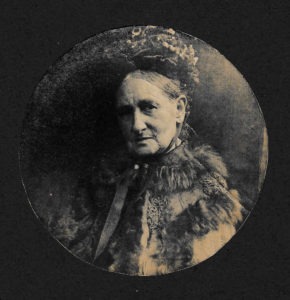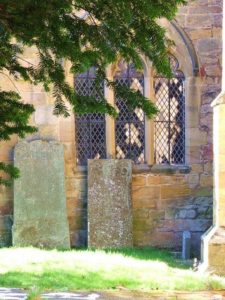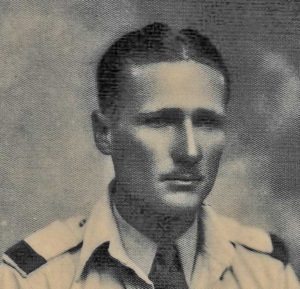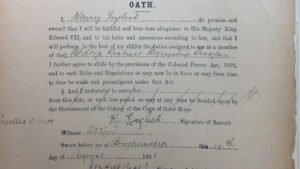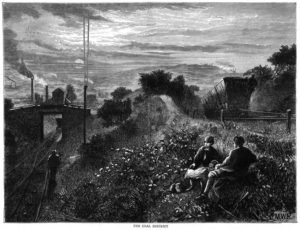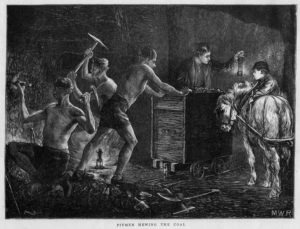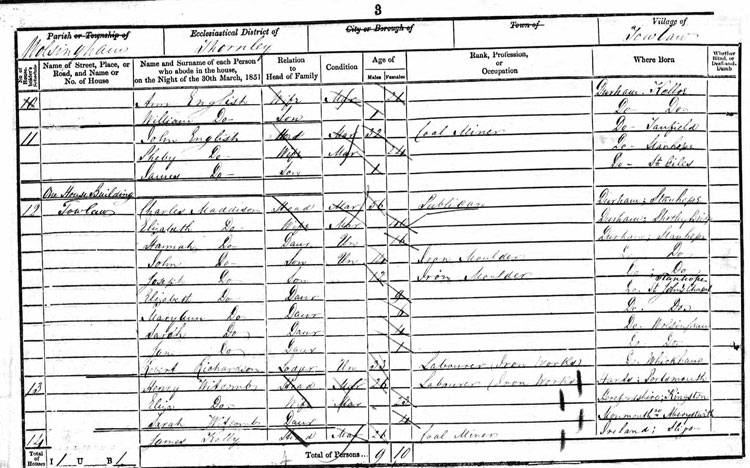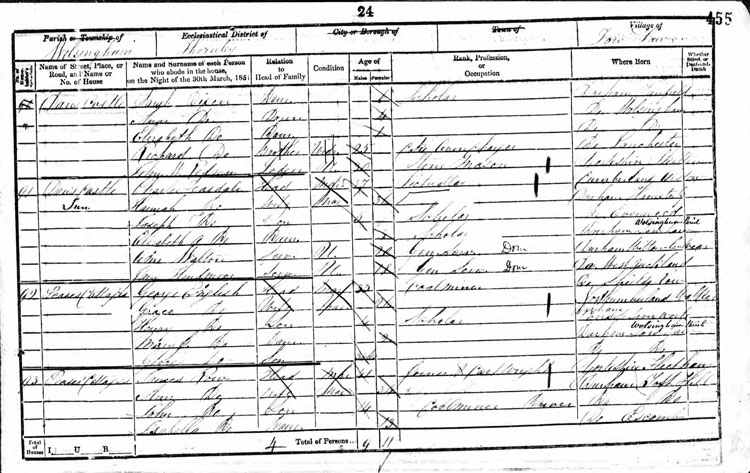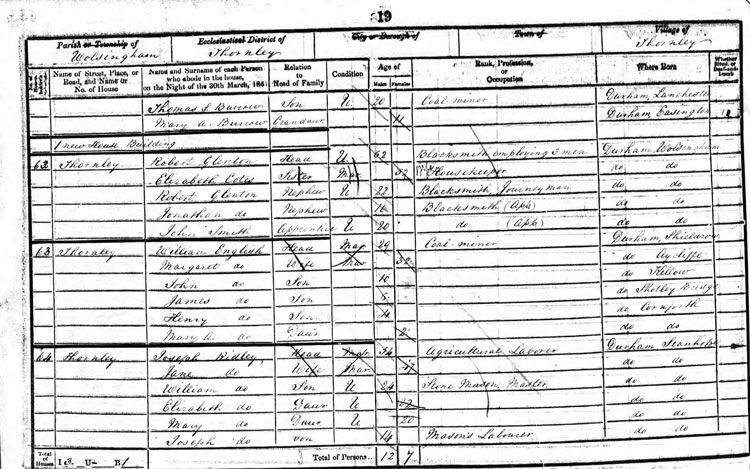This section has further information regarding WILLIAM’S grandfathers and great-grandfathers and their working lives in the North East.
Pre 1820s – Tanfield
Thomas English’s parents, William and Mary Turner were married at St Margaret of Antioch in Tanfield on 2 September 1815, and two of their first three children were baptised there too. When William and Mary married in Tanfield in1815 William probably worked at Willy Pit Tanfield Moor. However by this date there were at least ten other pits within a couple of miles of Tanfield where he could have been employed. Now in his mid thirties William would have been an experienced hewer earning an extremely good wage.
His first son John was born in Tanfield and baptised in 1816.
When George, their second son, was born in 1818 William’s address is given as Kip Hill, north of Stanley, a mile and a half or so south east of Tanfield village. Tanfield Moor Colliery was to the north west of the village and Tanfield Lea Colliery west of Kip Hill.
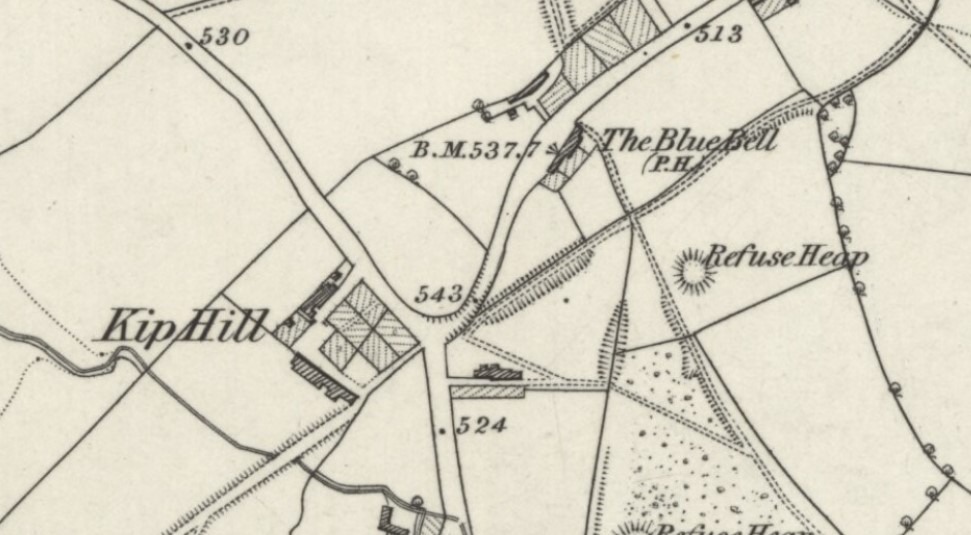
He appears to be at Kip Hill until after the baptism of his third son, also called William, in 1821, but by the time of his daughter Mary Ann’s baptism in March 1823 the family had moved to the Houghton-le-Spring area of Hetton, Easington Lane, in the township of Hetton. The Bond date was 5th April so this suggests they moved to Houghton at least as early as the previous April.
1820s – Houghton-le-Spring
As an experienced coal hewer and probably a mine sinker William would have been in great demand once new pits were sunk in the East Durham minefield. It had been previously thought there was no coal in this area but that all changed when the previously ‘concealed coalfield‘ was opened in Hetton in 1822. This was rapidly followed by Houghton-le-Spring in 1823.
Mary Ann’s baptismal day suggests the family had moved to Houghton the previous April for the opening of the new Hetton pit. (The South Hetton Colliery was sunk on 1st March 1831 and opened 5 August 1833).
We know they were still at Hetton in 1828 for Thomas’s birth (8/10/1828), for his younger brother Ralph (17/1/1830) and sister Margaret (15/4/1832), where they are recorded at Easington Lane, a village south east of Hetton. The family returned to Auckland for the baptism of his brother Robert Turner English (31/5/1834).
1830s – Hetton
During the 1831 strike Hetton was generally regarded at the heart of the Union, led by their elected leader Thomas Hepburn who worked there. Amongst their demands was one to stop the clause which empowers their masters to turn them out of their houses the moment the time of their hiring is up. (From Broadside Address, Delegate Meeting, Black Fell, 6 April 1831 Broadside The Pitmen of Tyne and Wear, Durham 1831). They also wished to control production (maximum 4s per man per day), control the labour market (won’t allow a stranger who is not a regular-bred pitman to come amongst them on any account) and take control of the pits.
For Hetton colliery alone I understand that between 8 and 900 Miners have been engaged to supply the places of ejected pitmen and as there are few Pitmen without Families this will give a tolerably accurate notion of the numbers who are utterly and permanently thrown out of employment’
Major General H Bouverie to SM Philips 1 June 1832, PRO,HO/40/30/2
Were they one of the families thrown out or did they just visit Auckland for Robert’s baptism?
1840s – East Hetton (also known as Kelloe)
Seven years later on 6 June 1841 (census day), they are at Joint Stock Colliery Houses, Kelloe, Easington Hundred, a mining village south west of Durham. The entire family are there with the exception of William junior who is living at Coundon, St Andrew Auckland, (most likely at the Leasingthorne Colliery opened in 1836). The annual binding date is 5 April so further research is needed to establish other changes in their address for these years.
For an insight into the working life at Kelloe, albeit some thirty years after William and his family were there, the poem Fifty Score a Day (and how we get them at Kelloe), written by James Carter, Kelloe, 30 May 1872 gives a detailed account of a working day in a colliery.
Kelloe was also a centre for Female Chartism during the late 1830s and 40s. It would be good to think that either Mary or one of William’s daughters was active in this movement although the bond was also used to get rid of troublemakers such as Chartists (in 1839, 66 men were imprisoned for attending the Chartist General Strike – imprisonment was allowed under the Bond), and many more were victimised at the April Bindings and put on what is called the black list.
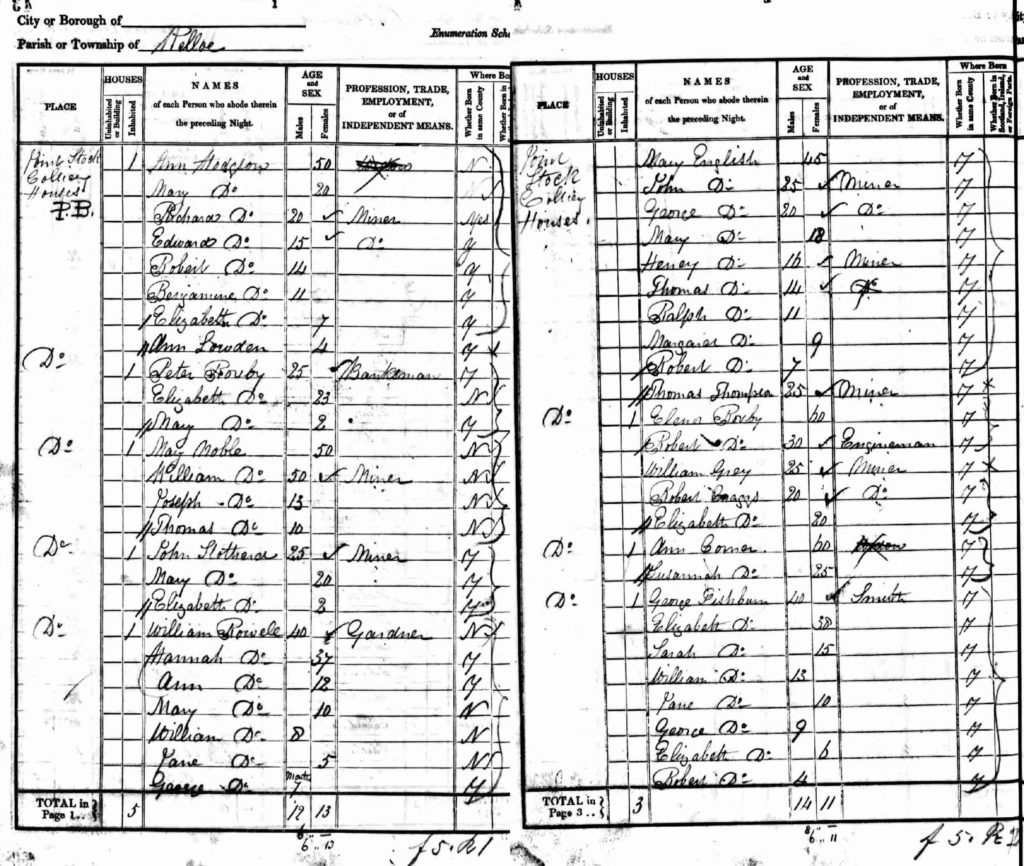
William Lawson’s parents John and Rachael, were also in Houghton le Spring in the 1820s. They were there at the time of William’s birth in 1827 but had, like the Englishes, moved to East Hetton, Coxhoe by census date 6 June 1841. How and why both families relocated to East Hetton, (also known as Kelloe Colliery, and opened in 1836), will need further research. Were John Lawson and William English established hewers or sinkers needed to open up the new coalfields? If so they would have been expected to work alongside the despised incomers from Cornwall, Wales and Ireland.
1850s – Ryton and Tow Law
We know that by the time of the next census, 30th March 1851, William Lawson had married Sarah Wallace and was living with his in-laws in Ryton Greenside while his father, John was still living in East Hetton village.
William Lawson continued to live in the Ryton area for the next 50 years until his death in 1903.
William English, however, seems to have migrated his entire family west. His address on 30 March 1851, six days before the bond, is 131 Corbridge Road, Tow Law with his wife Mary, daughter Mary Ann and two youngest sons, Ralph and Robert, whilst his eldest son John is at 10 Two House Buildings , Tow Law, with his wife and baby son. Also living with John is his younger brother Thomas with his wife and baby son. Another son George is at Pease’s Cottages , Wolsingham, Tow Law with his wife and children, whilst his son William and his family are at 1 New House Building Thornley, Wolsingham. Only Margaret who is in service for the Richardson family at Hedly Hope Colliery and Henry, an agricultural labourer at Meldon, Gosforth are missing. The date of the census tells us that the family must have been there since 5th April 1850 at least or earlier, but the reason for this move is not yet clear. Again, was it to do with the bond?

Analysis of the baptism places of the extended family may help with determining locations during the intervening years.
There had been a strike in May 1844 when a policy of eviction by the coal owners, with the support of the Home Office, led to 107 families being evicted in Lambton’s collieries; 174 at Hetton; 69 at South Hetton & Murton and 176 at the Londonderry collieries, a total of 526 families or over 2,000 men women and children.
The first evictions at Tanfield were treated in a festival atmosphere as the evicted were each celebrated as victors. The place was carefully chosen as ‘an outside `and thinly populated portion of the Colliery district…for the purpose of awning and intimidating the orderly and well-disposed portion.
INFORMATION COMPLAINTS OF OWNERS AND AGENTS 5/6 JUNE 1844 HO/45/644 CITED ON PAGE 300 IN THE PITMEN OF THE NORTHERN COALFIELD, ROBERT COLLS (1987)
Londonderry himself was bringing over Irish labourers as replacements. Was William evicted from Hetton?
Many blacklisted men came from a Poor Law Union other than the one they were living in so once destitute the Poor Law Union Guardians could expel them and their families from the parish. In 1843 in the villages of Wingate, Monkhesledon and Thornley there were 40 such groups of the migrant-destitute awaiting escort.
When RESTRICTION was broken the Union used shaming to enforce its influence by naming names. Post 1844 the Bond and Blacklisting were being used systematically so that in 1846 The Commissioners reported a victimised and frightened coalfield.
The Henry English referred to in the Caution to Pitmen in the Morpeth Herald of 6 November 1858 may have been William and Mary’s son born in 1825, although he is referred to as a young man in the article. The article demonstrates the punitive acts towards pitmen. More research is needed.
A glance at the family’s life events during the 1850s gives some impression of how the family dispersed. Both William the third son, leaving a wife and four young children, and Mary Ann, the elder daughter, died within months of each other during the winter 1851/2.
By 1852 George and Grace were living in Shotley Bridge near Tanfield (baptism of son William on 1 August) and they were soon joined by John and Phoebe (baptism of son Caleb 30 October 1853). In 1854 Grace died leaving George to bring up four children under ten. By 30 November 1858 (Margaret Ann’s baptism) Thomas and Ann had followed them to the Tanfield area. When George remarried in March 1857 he and his second wife Elizabeth Vickers soon moved to Whickham.
| YEAR | NAME | ADDRESS | OCCASION | REFERENCE |
|---|---|---|---|---|
| Q4 1851 | William 3rd son (b1821) | Durham | Death | XX1V 53 |
| Q1 1852 | Mary Ann English, (b 1823) 1st daughter | Houghton le Spring | Death | 10a 153 |
| 1/8/1852 | William English, son of George English & Grace | Weslyan Methodist, Shotley Bridge, Durham | Baptism | FHL 2107176 |
| 31/10/1852 | George (Thomas & Ann’s 2nd son) | Thornley. Tow Law | Baptism | FHL 1514657 |
| 30/10/1853 | Caleb, 2nd son of John, 1st son and Phoebe | Weslyan Methodist Shotley Bridge | Baptism | FHL 2107176 |
| 5/5/1854 23/6/1854 | HENRY GGFather, 3rd son Thomas & Ann | Brown’s Houses Tow Law (Wolsingham) Durham | Birth Baptism | Birth Certificate FHL 1519884 |
| 4/6/1854 | Ralph English, 7th son & Jane Hindmoor | Thornley, (near Tow Law) | Marriage | Find my Past r 845233831 |
| Q2 1854 | Grace, wife of George English (2nd son) | Weardale | Death | 10a 99 |
| Q4 1854 | Margaret English (2nd daughter) & Jacob Ro(w)e | Lanchester | Marriage | 10a 360 |
| 1856* | WILLIAM 3xGFather and Maria Richardson | Weardale, Durham | 2nd marriage aged 61 | Ancestry family tree to be verified |
| 21/3/1857 | George English and Elizabeth Vickers | Whickham, Durham | 2nd marriage after Grace’s death | 10a 580 |
| 30/11/1858 | Margaret Ann English, 1st daughter Thomas & Ann (Aunt Meggie?) | Shotley Bridge,Tanfield | Baptism | Durham 10a 197 FHL 2107175 |
1860s and 70s – On the move
William English is found on the 1861 Census at 115 Long Row Byers Green, Newfield, north of Bishop’s Auckland with his wife Maria, his first wife Mary having died pre 1851. (A marriage to Maria Richardson in 1856 in Weardale confirms this) His place of birth is given as Buckland, (Bishop’s Auckland wrongly transcribed). He claims he is still a miner although he is now nearly 70 years old!
Why he moved back to the area he was born in is anyone’s guess – perhaps it was the bond – but his son John is also found in the same street in the 1861 census on 7 April, having moved from Shotley Bridge. He too is a miner but at which colliery?
(From 1852 to 1946 the Civil Registration district Weardale covered all that part of Durham west of Lanchester in the north, and Auckland in the south)
The 1860s show a pattern of movement similar to the 1850s.
On 7 April only Ralph and Margaret of the remaining seven children are still living in Tow Law; John is in Byers Green with his father and George is in Whickham (he dies there in 1863). Henry has now moved to Tanfield and Robert completely out of the district to Derbyshire.
There is a death of a William English in Weardale (Q2 1863 10a /138) which is probably that of William’s great grand father.
| YEAR | NAME | ADDRESS | OCCASION | REFERENCE |
|---|---|---|---|---|
| 7/4/1861* | WILLIAM ENGLISH 3x GF | 115 Long Row Byers Green Newfield Bishops Auckland | Census* | RG9/3711* To be verified – Seems most likely |
| 7/4/1861 | John English 1st son 43, Phoebe 33, James 11, William 10, John Edward 2, | 149 Long Row Long Row Byers Green Newfield Bishops Auckland | Census | RG9/3711 |
| 7/4/1861 | George English, 2nd son, wife Elizabeth, Henry 14, Mary 12, George 10, William 8, John 2, Isabella 4 months | Waggonway Row, Fellside, Harley Hill, Whickham | Census | RG 9/3807 |
| 7/4/1861 | THOMAS ENGLISH 5th son 30, 2x GF Ann 30, William 11, George 9, HENRY 6, Margaret 2 | ‘Isle of Man’ Tanfield | Census | RG9/3729 |
| 7/4/1861 | Ralph English 6th son, wife Jane, ds Mary Ann 5, Margaret 1, son William 3 | North Street, Tow Law Village, Wolsingham | ditto | ditto |
| 7/4/1861 | Jacob Rowe, wife Margaret (nee English 2nd daughter), d Mary Ann 4, sons Jacob 2, William 9 months | North Street, Tow Law Village, Wolsingham | Ditto Margaret Rowe is Ralph’ s sister | ditto |
| 7/4/1861 | Robert Turner English 7th son, wife Ann, ch. Mary Ann 5, William H 3, John 1, George Willis father in Law | Sheepbridge, Cavendish Square, Newbold & Dunston, Derbyshire | Ditto | RG9 2530 |
| 1862 | Mary Jane 2nd d of Thomas (5th son) & Ann | B Tanfield | 1871 Census | |
| Q2 1863 | WILLIAM 3xGF | Weardale Durham | Death | 10a/138 |
| Q3 1863 | George English 2nd son | Gateshead | Death | 10a 350 |
| 1866 | Ridley English, 4th son Thomas & Ann | B Hemsley | 5 years old on 1871 census, | |
| Q2 1868 | John 1st son | Hartlepool | Death | 10a 65 (to be confirmed – not on 1871 census) |
In 1869 The Durham Miners Association was formed. It aimed to have a lodge in every colliery a mini welfare state for the miner which would provide recreational, welfare and educational resources.
As our main interest is in WILLIAM’S immediate family, parents, grandparents (and great grandparents when we know them), it would be useful to view the above chart, (without the extended family), to see the family’s changes of address over the next decade. We can then add the 1870s, 1880s and 1890s to get an overview.
Decade: 1860s
| YEAR | NAME | ADDRESS | OCCASION | REFERENCE |
|---|---|---|---|---|
| 7/4/1861 | THOMAS ENGLISH 5th son 30, 2x GF Ann 30, William 11, George 9, HENRY 6, Margaret 2 | Isle of Man Tanfield | 1861 Census | RG9/3729 |
| Q2 1863 | WILLIAM 3xGF | Weardale Durham | Civil Death Registration | 10a/138 |
| 1866 | Ridley English, 4th son Thomas & Ann | B Hemsley | 5 years old on 1871 census, | |
Decade: 1870s
| YEAR | NAME | ADDRESS | OCCASION | REFERENCE |
|---|---|---|---|---|
| 1870 | Dorothy, 3rd d of Thomas & Ann | New Delaval, Horton (Earsdon) | Birth | 1871 Census |
| 2/4/1871 | THOMAS 5th son, wife Ann 41 b Kelloe William 21 b Kelloe George 19 b Tow Law Henry 16 b Tow Law Margaret Ann 16 b Isle of Man (Colliery) Mary Jane 9 ditto Ridley 5 b Hemsley Dorothy 1 New Delaval | 10b Double Row Horton, Woodhorn | Census | RG10/5121/32 |
| Q4 1871 | William English 1st son Thomas & Ann, & Sarah Freeman | Newcastle upon Tyne | Marriage | 10b 169 |
| 1872 | ABOLITION | OF THE | MINER’S | BOND |
| 27/2/1875 | HENRY ENGLISH 3rd son Thomas & Ann, & Margaret LAWSON | Wylam | Marriage St Mary the Virgin Ovingham | Q1 1875 Hexham 10b 247 |
| 18/12/1875 | George English 2nd son of Thomas & Ann, & Isabella Watson | St Nicholas Newcastle upon Tyne | Marriage | FHL 1068652 Ref: 2:3C087FT or FHL 2103448 Ref: 92 |
| 29/12/1875 | WILLIAM ENGLISH Grandfather and diary writer | Wylam | Williams birth | Journal + b. cert Q1 1876 Hexham 10b 311 |
| 29/9/1878 | Sarah Ann WILLIAM’S sister | Wylam | Sarah Ann’s birth | Journal |
1880s – From Wylam to the East Coast
| YEAR | NAME(S) | ADDRESS | OCCASION | REFERENCES |
|---|---|---|---|---|
| 3/4/1881 | THOMAS ENGLISH, Ann, Mary Jane, Ridley, Dorothy Elizabeth | Togston, Alnwick, St Lawrence Warkworth | Census | RG11 |
| 3/4/1881 | George English, wife Isabella | Wylam | Ditto | RG11 5100 |
| 3/4/1881 | HENRY, Margaret, William, Sarah Ann | Ship Hill, Wylam Hill | Census | RG11 5100 |
| 1882 | HENRY, Margaret, William, Sarah Ann | Victoria Road, South Shields | HENRY works at Whitburn | William’s Journal + electoral reg |
| 1885/6 | Ditto | Chevington Abbas (a farm) | HENRY works at Stobswood | Ditto |
| 1886 | Ditto | Ditto? | Stobswood ‘for a year’ | Ditto |
| 1887 | Ditto | Pegswood | HENRY at Ashington, Pegswood being closed | Ditto |
| 1889 | WILLIAM | WILLIAM begins work at Ashington | Ditto |
1890s – Pegswood to Victoria Garesfield
| YEAR | NAME | ADDRESS | OCCASION | REFERENCE |
|---|---|---|---|---|
| 1890 | WILLIAM | WILLIAM started at Pegswood (closed previous 13 years) | Ditto | |
| 5/4/1891 | THOMAS ENGLISH Widower | Stobswood colliery | Census | RG12/4260 |
| 5/4/1891 | HENRY (Harry), Margaret, WILLIAM and Sarah Ann | 87 Spencer Place PEGSWOOD, Morpeth | Census | RG12/4258 |
| 5/4/1891 | Jane Leybourne (Laybourne) ‘Aunt Jane at the Spen’ | 42, Ramsey’s Cottages, Chopwell, SPEN | Census | RG12/4190 |
| 1892 (Jan) | Death of William’s mother Margaret | Burial: Bothal Church | William’s Journal | |
| 1892 | WILLIAM and Henry | ‘Seghill for a year’ | Ditto | |
| 1893 | WILLIAM and Henry | Lived with Aunt Meggie Wright at Gateshead | Ravensworth | Ditto |
| 1894 | WILLIAM | Lived with Aunt Jane Laybourne at The Spen. | Victoria Garesfield | Ditto |
| 1894 – Jan ‘97 | Henry | Mention of Uncle Bill Lawson, Weslyan church | Emmaville | |
| 1895 | Henry | Signed to go to the Transvaal | Ditto | |
| 1896 | Henry | Left for South Africa | Ditto | |
| 1897 | Henry sent for William to join him | Mention of sister | West Ryton | Ditto |
| 22nd Feb 1897 | William sailed from Southampton on Union Castle boat Athenian to South Africa | Ditto |

